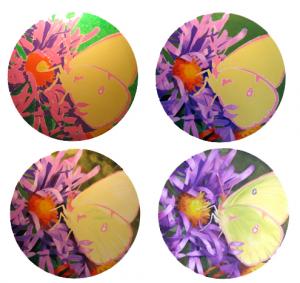Sale on canvas prints! Use code ABCXYZ at checkout for a special discount!

NEWSLETTER February 2010
Greetings from the mountains of western Maine!
First, the unfinished business: I am done with the painting that I was working on last fall when I had to leave for Cleveland. I painted it in several successive layers. You can see the progression here, from the first underpainting to its current state.
This is a 20” diameter oil painting on canvas. The image is taken from the watercolor that I did of the asters and butterfly, but it zeroes in on the butterfly and one flower. I started out with bright colors and simple shapes in the underpainting, and gradually refined them until I was satisfied that I had said what I wanted to say. I like the profusion of petals and the way the light hits them. I am fascinated with light and what it does to color, so I am planning some concentrated study in that area next.
The remainder of February was spent studying the white pine, the gentle giant of the northeastern conifers. Its needles are long and soft instead of aggressively sharp or stiff like other pines, and it can grow one hundred feet tall or more. The white pine is the Maine state tree, and the pine cone and tassel is our state flower. You can see my study book page about white pines here on my Fine Art America site.
White pines are inextricably bound with Maine’s history. They have formed a major part in many industries here over the years. Because its soft, light wood does not warp or crack as easily as other trees, it has found its way into buildings, cabinets, furniture, boxes, and patterns as well as the masts of ships.
The living room in our 180-year-old farmhouse is paneled with the original “pumpkin pine” boards taken from the loft floor when the house was remodeled. Pumpkin pine is the deep orange heartwood of old growth pine trees. The boards over our fireplace mantel are slightly less than twenty-four inches wide.
In American colonial days, all good trees two feet or more in diameter on land not previously granted to a private individual were reserved for masts for His Majesty’s Royal Navy. A fine of £100 was levied against anyone who cut a tree marked with the King’s “broad arrow.” So boards in Mainer’s homes were never, ever more than twenty-four inches wide, even if they came from a larger tree. They were carefully trimmed to remove any possibility of incriminating evidence!
If you would like to receive an email of my newsletter with the free art card file attached, send me a message and I would be delighted to oblige you.
This time the art card image is one of “pine candles,” the pale green shoots on the pine tree branch tips in the spring. It was digitally reworked from a 3” diameter round miniature. Art cards (or ACEO’s) are a collectible form of miniature art the same size as a baseball trading card. Print this one on good stiff photo paper, cut it out, and start your own collection, if you wish. I give you permission to print or reproduce this image as you choose.
For more information on “Swift River Treasures,” my art-making process, or recent work, or to check out my blog, see my website at http://betsy-bell.fineartamerica.com. Fine Art America offers a great print-on-demand service with optional matting and framing. They also sell greeting cards with my work on them.
This month’s collector’s tip is from my friend Pat Chandler, a career professional artist in Norway, Maine. You can see her work at http://www.chandlerfineart.com. She asked me to stress how important it is to an artist to get feedback from collectors, and how the relationship between artist and art-lover develops. “Many clients have repeatedly told me how important the artworks they've bought from me are to them. So I have taken opportunities, like holidays, to write notes and say in some way how meaningful it is to me to know that. I find some way to acknowledge that we have become part of each others' lives.”
I would like to paint the way a bird sings. (Claude Monet)
Thanks for joining me in the journey. I hope that you enjoy looking at the art as much as I have enjoyed making it! I would love to hear from you, too, so please do reply with comments.
Betsy
(to recieve a monthly newsletter from me, just sent me an email and I will add you to my list.)